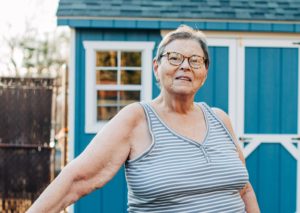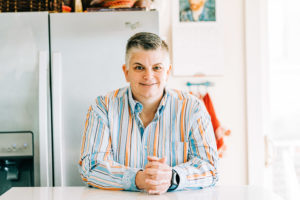How often do you think about your shoulders? Not much — except when injuries to these joints happen and resulting pain and mobility problems cause a ripple effect. Suddenly you’re forced to rethink simple things like hoisting a toddler or reaching for a plate on a higher shelf. This can really impact your quality of life.
There are viable fixes for many shoulder problems that require surgery, and Mather Hospital has experts who can get you back on track. Here are two patients who’ve found relief and renewed mobility.
From pain to relief
 When 70-year-old Barbara Meyer fell while getting into a pool nearly three years ago, she suffered a fracture dislocation of her shoulder. To repair it, Richard Savino, MD, an orthopedic surgeon at Long Island Bone & Joint, a division of Orlin & Cohen, working at Mather Hospital, put several pins in her joint, and although the fracture healed well, the joint was badly damaged.
When 70-year-old Barbara Meyer fell while getting into a pool nearly three years ago, she suffered a fracture dislocation of her shoulder. To repair it, Richard Savino, MD, an orthopedic surgeon at Long Island Bone & Joint, a division of Orlin & Cohen, working at Mather Hospital, put several pins in her joint, and although the fracture healed well, the joint was badly damaged.
The damaged joint started to cause issues about a year ago, limiting her range of motion. Even everyday tasks like carrying a laundry basket, grocery shopping and brushing her hair had to be adjusted to using the non-injured shoulder. But favoring the other shoulder can be problematic, too, since it increases risk of overuse injury.
Dr. Savino suggested shoulder replacement surgery, which would alleviate her pain and hopefully restore proper function. By the time she had surgery in June 2020 — the procedure was delayed by early COVID-19 restrictions — the pain and immobility had become impossible to ignore.
“What I appreciated was that Dr. Savino was very calm, he explained everything so I knew what to expect, which is comforting when you’re in pain,” said Ms. Meyer.
Dr. Savino is one of the surgeons who helped launch Mather Hospital’s Joint Replacement Program more than 10 years ago, and he appreciates the program’s focus on dedicated teams and a patient-centric approach.
“At Mather, you have a personalized experience,” he said. “I take my time with each patient to ensure they feel comfortable and happy, and that they’re getting the best possible outcome.”
In addition to surgery, that means a strong emphasis on recovery. Ms. Meyer found that part fairly easy, even pleasant. After physical therapy for six weeks following the procedure, she’s continued to exercise and feels that her progress is excellent.
“I’m just so relieved to be able to live without pain and do everything I want to do,” she said. “I have probably 90 percent of my movement back. If I had to do it over again, I wouldn’t change a thing.”
From limitations to snowball fights
 It was the kind of moment any mom could have: Holding her 5-year-old son’s hand while standing in the waves at the beach in 2019, Erika Shapiro got knocked down by a big surge, but made sure she didn’t let go of her boy. The pair were fine, but Ms. Shapiro’s shoulder took the brunt of it as she got tossed around. The result: a major rotator cuff tear and a torn biceps tendon.
It was the kind of moment any mom could have: Holding her 5-year-old son’s hand while standing in the waves at the beach in 2019, Erika Shapiro got knocked down by a big surge, but made sure she didn’t let go of her boy. The pair were fine, but Ms. Shapiro’s shoulder took the brunt of it as she got tossed around. The result: a major rotator cuff tear and a torn biceps tendon.
She needed surgery to repair her injuries, and turned to shoulder specialist Gregory C. Mallo, MD, of Orlin & Cohen Orthopedic Group. After a successful surgery and a few months of physical therapy, the now 47-year-old was able to return to her job as a nurse. Then, last year, the other shoulder began to ache.
Since Ms. Shapiro has rheumatoid arthritis and had played sports when she was younger, Dr. Mallo attributed the pain to a rotator cuff tear caused by overuse. An MRI revealed a cyst under the bicep tendon as well as a significant rotator cuff tear. This meant she’d need a similar procedure to the one she’d had the previous year.
“We were able to do a minimally invasive technique in a very efficient and effective way, leading to a shorter time in surgery and a faster recovery,” said Dr. Mallo. “Before surgery, she was having difficulty taking care of herself and her two young children, and now she’s able to do pretty much whatever she wants.”
Ms. Shapiro is grateful that now when her son, 7, and his 4-year-old sister ask, “Mommy, can you play with us?” she can say yes. Just a month after surgery, she was helping build a snowman and having snowball fights. She also “fences” with foam swords in the living room.
“It’s little moments like that — you don’t realize how important they are until you can’t do them,” she said. “I’m grateful for the feeling of getting stronger and more mobile every day.”

